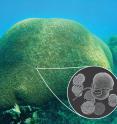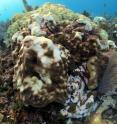Invasive microbe protects corals from global warming, but at a cost
Related images
(click to enlarge)
An invasive species of symbiotic micro-alga has spread across the Caribbean Sea, according to an international team of researchers. These single-cell algae, which live within the cells of coral animals, are improving the resilience of coral communities to heat stress caused by global warming, but also are diminishing the abilities of corals to build reefs. "The results raise a potentially contentious issue about whether this invasion is relatively good or bad for the long-term productivity of reef corals in the Atlantic Ocean and the ecosystems they support," said Todd LaJeunesse, associate professor of biology, Penn State.
The team's findings appear in today's (JUNE 1) issue of the Proceedings of the National Academy of Sciences.
According to LaJeunesse, relationships between corals and photosynthetic algae evolved over millions of years and are generally mutually beneficial. Corals derive energy and nutrients from algae, and in turn algae obtain nutrients and protection by living in the tissues of corals.
"Coral reefs are highly important to the biosphere, and they also have enormous economic and societal value in the form of tourism, recreation and coastal protection, and as a source of food and pharmaceuticals," said LaJeunesse. "Currently, these ecosystems are threatened by synergistic effects of diminished water quality, increased temperature and reduced ocean alkalinity."
LaJeunesse and his team, which includes researchers from the University of Delaware and the Universidad Nacional Autonoma de Mexico (UNAM), used DNA sequencing techniques to document this possible new threat to coral reefs -- the spread of non-native, Symbiodinium trenchii, which comes from the Indo-Pacific.
To determine that S. trenchii's presence in the Caribbean likely came from a limited introduction and then began to spread, the team used population genetic markers to analyze the genetic diversity among populations of S. trenchii in the Indo-Pacific and compared this diversity with that in the Caribbean Sea.
"We found that the Caribbean population of S. trenchii contains very little genetic diversity and is highly inbred," said Tye Pettay, recent Ph.D. in biology, Penn State and current postdoctoral fellow, University of Delaware. "In contrast, S. trenchii in the Indian and Pacific oceans is extremely diverse and contains far more genetic diversity on a single reef the size of a football field than it does in the entire Caribbean Sea. Our evidence indicates that the introduction of S. trenchii to the Caribbean was relatively recent. There has been no time for it to evolve any novel genetic diversity."
In its new home in the Caribbean, the team found, S. trenchii behaves opportunistically and proliferates within coral colonies during periods of increased sea-surface temperatures, enabling the corals to survive these episodes. During these warming events, S. trenchii replaces the more sensitive native species of algae, which are expelled by their hosts when the environment becomes too warm -- a process known as bleaching. S. trenchii eventually is replaced by native species of algae after environmental conditions return to normal.
"For some time now researchers have focused on identifying stress-tolerant Symbiodinium that may allow reef corals to better cope with future increases in temperatures," said Pettay. "Symbiodinium trenchii in the Caribbean possesses those attributes. It turns out, however, that because this species was introduced to the region, its symbioses may be suboptimal, which may significantly diminish coral growth under normal conditions."
Specifically, the researchers found that S. trenchii benefits some colonies of coral by providing them with thermal tolerance under conditions up to 3.6 degrees Fahrenheit higher than normal, yet the team also found that for one group of dominant reef-building corals, Mountainous Star Coral, S. trenchii reduces rates of calcification -- the process by which reefs are built -- by half.
"Our results indicate that S. trenchii may not translocate as many nutrients to the coral host as do native species, which is why we see reduced calcification rates among the corals," said LaJeunesse.
The retention of more nutrients to invest in its own growth and physiology may explain, in part, why S. trenchii can continue to function under heat stress and is not expelled by the host during warming events, he added. As a result, corals with S. trenchii tend not to bleach.
"Invasive species pose major threats to biodiversity, ecosystem function and economic well-being," said LaJeunesse. "Growing evidence indicates that microbes, which include micro-algae, are being successfully introduced to new places around the world, but we still have little understanding of the negative or positive outcomes from such introductions. This work highlights how microbial introductions, many of which may be unknown to science, can affec ecosystem stability and function -- in this case, reduced calcification of corals in the Caribbean."
Source: Penn State
Articles on the same topic
- New study uncovers why some threatened corals swap 'algae' partnersThu, 4 Jun 2015, 16:37:52 UTC
- Hitchhiking to Caribbean coralTue, 2 Jun 2015, 15:37:22 UTC
Other sources
- Why some threatened corals swap 'algae' partnersfrom Science DailyThu, 4 Jun 2015, 16:30:18 UTC
- New study uncovers why some threatened corals swap 'algae' partnersfrom PhysorgThu, 4 Jun 2015, 10:00:16 UTC
- Invasive microbe protects corals from global warming, but at a costfrom Science BlogTue, 2 Jun 2015, 15:30:41 UTC
- Invasive microbe protects corals from global warming, but at a costfrom Science DailyMon, 1 Jun 2015, 22:30:35 UTC
- Hitchhiking to Caribbean Coralfrom Newswise - ScinewsMon, 1 Jun 2015, 19:30:34 UTC
- Team reports new evidence that microbial algae in Caribbean came from the Pacific; could do long-term damagefrom PhysorgMon, 1 Jun 2015, 19:00:31 UTC


